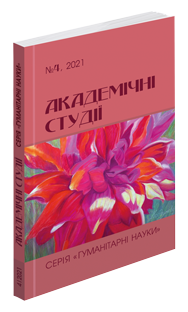Abstract
The paper deals with speech behaviour of literary characters in the novel by Joan Rowling “The Cuckoo’s Calling”, and linguo-communicative strategies of criticism and disapproval in their interaction, in particular. The research makes an attempt to remodel the main character’s language identity and linguo-cultural social patterns typical of the environment where communication is taking place. The paper contributes to exposing linguistic manifestation of criticism and disapproval in literary characters’ verbal communication as well as to building a comprehensive language model of a literary character.
The research carried out shows that similar to politeness strategies, which are phrased in a range of clichés, in the situations of criticism and disapproval, speakers tend to apply a set of linguo-communicative strategies. Among explicit strategies of disapproval, naming (or labeling), negative attribution and negative interpretation, devaluation, rebuttal, negation and prohibition are the most common ones. The paper also identifies implicit disapproval strategies, such as pseudo questions, pseudo apologies, ascribing, hints, end-of-conversation signals. Situation of criticism prove to be less common in the literary characters’ communication, reproaching and accusations (with or without reasoning) are normally related to the speakers’ intention to influence the behaviour of the addressee or to make a critical utterance look more rational and objective.
Speech behaviour of the main character marked by inquiring, refrain from voicing his opinion, avoiding confrontation projects the image of a highly professional person with a unique capacity of self-control, which manifests itself through the strategy of “non-articulation”. Readers perceive it through the character’s “inner speech”.
References
Бєлєхова Л.І. Словесний образ в американській поезії: лінгвокогнітивний аспект: монографія. Москва : ООО «Звездопад», 2004. 376 c.
Бехта І.А. Авторське експериментаторство в англомовній прозі ХХ століття. Львів: ПАІС, 2013. 265 c.
Волкова С.В. Принципи конструювання міфолорного простору англомовних амеріндіанських художніх прозових текстів. Когнітивна лінгвістика в міждисциплінарному контексті: теорія і практика. 2016. С. 43–44.
Волкова С.В. Міфолорний простір англомовних америдіанських художніх текстів: когнітивно-семіотичний і наративний аспекти: автореф. дис. … докт. філол. наук. Київ, 2016. 32 с.
Воробьёва О.П. Словесная голография в пейзажном дискурсе Вирджинии Вульф: модусы, фракталы, фузии. Когниция, коммуникация, дискурс: (сб. науч. тр.). Харьков: ХНУ им. В. Н. Каразина, № 1, 2010. С. 47–74.
Вольф Е.М. Функциональная семантика оценки. Москва, 2002. 280 с.
Горчак Т.Ю. Архетипні словесні образи-символи в американській поезії ХХ століття: лінгвокогнітивний аспект. URL: http://bo0k.net/index.php?p=achapter&bid=10503&chapter=1
Гулієва Д.О. Комунікативні стратегії негативної оцінки (на матеріалі англомовних ігрових кінофільмів). Вісник Харківського національного університету ім. В. Н. Каразіна : зб. наук. праць, 2018. Вип. 87. С. 92–99.
Маріна О.С. Інтердискурсивність у конструюванні парадоксальності в сучасному англомовному поетичному дискурсі. Наукові записки Національного університету Острозька академія. Серія: Філологічна. Вип. 64, ч. 2., 2017. С. 20–25.
Мартынюк А.П. Когнитивно-коммуникативная лингвистика: в поисках базовых принципов и методик анализа. Когниция, коммуникация, дискурс : сб. науч. тр., № 12, 2016. С. 17–35.
Образцова О.М. Синтаксичні особливості мовлення персонажа художнього твору: перекладацький аспект. URL:https://www.academia.edu/23465007/
Філіпчик О.Й. Синтаксичні засоби створення образу (на матеріалі сучасної американської поезії): автореф. дис. … канд. філол. наук. Одеса, 2000. 32 с.
Austin, J.l. (1975). How to Do Things with Words. Harvard University Press, 168 p.
Brown, P., Levinson, S. (1978). Universals in language usage: politeness phenomena. Questions and Politeness: Strategies in Social Interaction. NewYork : Cambridge University Press, рр. 56–289.
Levinson, S. (1983). Pragmatics. Cambridge: Cambridge University Press, 236 p.

